Reach Leadership Toolkit
Welcome!
Who Are Reach Leaders?
Reach Leaders work to raise funds and awareness for children and families facing the financial burdens of a cancer diagnosis, in our chapters’ own communities, while helping students develop their skills and reach their goals. Membership allows students to collaborate and learn about advocacy, event planning, cancer, and its financial toxicity while supporting Family Reach.
Family Reach Mission Statement
Family Reach is a national 501(c)(3) nonprofit organization dedicated to removing the financial barriers standing between a cancer patient and their treatment. Loss of income, out-of-pocket expenses, and socioeconomic factors create disparities in the financial burdens families face. Family Reach delivers financial education, financial planning, resource navigation, and emergency relief funds to patients and caregivers facing a cancer diagnosis so no family has to choose between their health and their home.
Reach Leadership Mission Statement
Reach Leadership is a nationwide movement of high school and college students committed to helping cancer patients and their families through the Family Reach mission.
Table of Contents
Who is Family Reach?
Family Reach was established as a joint effort of the families of Christopher Colangelo and Kristine Morello-Wiatrak. In 1981, 11-year-old Christopher lost his battle with neuroblastoma. Kristine passed away in 1995 at 27 years old after fighting Ewing’s sarcoma, a pediatric type of cancer. The Colangelo and Morello-Wiatrak families were astounded by the expenses associated with treatment that compounded during the challenge of helping their loved ones—transportation, special nutrition needs, daycare, etc. Motivated by their personal experiences, both families independently sought to help others with the financial and emotional burdens of pediatric cancers.
Things to Know Before You Begin
Family Reach’s Mission
How Family Reach Assists Cancer Patients and Families
Camille’s Story
The Sampsons’ Story
Giraldy’s Story
Financial Burden Statistics

Cancer patients who file for bankruptcy have a 79% greater risk of early mortality.

1 in 3 families are unable to meet their own basic needs while a child is in cancer treatment

Cancer patients are 2.65x more likely to go bankrupt than people without cancer.
Beginning Your Chapter
When you’re ready to start your chapter, follow these steps to make it official.
Tips for a Successful Start
Finding a good faculty or parent advisor is essential for the success of your Reach Leadership chapter. You will closely collaborate and work alongside this individual for the entirety of your Reach Leadership experience. This person can help navigate your school or university’s guidelines, and be an impactful voice in brainstorming sessions.
When looking for an advisor, here are some questions to consider.

Ultimately, if the person you are considering feels right, go ahead and ask them. Finding and solidifying an advisor is a very personal process. Don’t be afraid to ask or interview a few different people, and don’t be discouraged if some decline the offer. When you find an advisor who’s ready to take on the job, set up a time to discuss your plans and ideas for your chapter.
A successful Reach Leadership Chapter requires frequent collaboration. In addition to finding a strong faculty or parent advisor, you will need to establish a strong student-based executive board. When you’re first starting your chapter, it can be helpful to identify potential board members within your inner circle that you know and trust. As your chapter evolves and your interest grows, you can establish a new system of determining board members from Reach Leaders who show an interest in a board position and have strong leadership capabilities, as well as a visible dedication to the Reach Leadership chapter and Family Reach’s mission.
There are several executive board formats to choose from, which is another personal decision to make based on your chapter and population. Here are some examples of formats that have been used, although different ones can be determined based on how you want to design and structure your chapter:

Promote good, organized, and regular communication between E-board members, faculty or parent advisor, and Family Reach’s staff. Consider starting a group text, email thread, or schedule check-ins on an annual basis. Also, schedule regular E-board check-ins with Ethan Michaud to see if the organization can help support your projects in any way.
Writing out a club charter ensures that both your club and board members understand the expectations of being a Reach Leader, including the time commitment, attendance policies, and other basic functioning of your branch. You will want to collaborate with E-Board members to formulate your charter and gain a majority vote from club members in favor of your club charter.
Check out this Example Club Charter to get started on establishing yours. Refer to your club charter, and amend it through any difficulties that could be caused by a lack of communication.
Not all Reach Leadership branches hold the same philosophies or have the same goals, so consider what you want to do through your branch. Do you want to just fundraise? Do you want to hold events that can spread awareness? Do you want to do any work with families directly? Reconsider your goals annually or on an as-needed basis. As your club expands, you may find that you have opportunities to do more. Reach out to Family Reach directly if you have any ideas about potential projects!
Setting up ground rules is essential in order for club meetings and other operations to run smoothly. Think about any club rules or guidelines for members. If you are operating virtually, will you require members to have their videos on? Will you require all members to share or provide input on an idea? Lay these rules out clearly for members to refer back to.

Could this person become inspired and passionate about this cause?

What does this individual’s schedule look like? Will they have time for club meetings and events?

Does this person have any previous experience working with nonprofits, advising clubs, or a connection to cancer?
Is it likely that this individual will stay at or be involved with the school/university beyond your graduation?
Traditional Board Set Up
Board operates as a team with individuals assigned to designated club duties. This allows for both independent work and collaboration. There is some room to ensure the club’s continuation after upperclassmen board members graduate and leave the club
(Example: The Secretary and Treasurer could become candidates for President and Vice President)
President
Vice President
Collaborative Board Set Up
Board operates as a “mentoring” program to ensure the club’s continuation after upperclassmen’s graduation from school or university. This structure of Co-Presidents and Co-Vice Presidents (one junior or senior, and one sophomore in each role) invites underclassmen to become more involved and learn leadership skills from upperclassmen. It offers a more collaborative, team-oriented approach to running Reach Leadership.
Co-Presidents
Co-Vice Presidents
Treasurer
Secretary
Club Representative
Promotion and Recruitment
The promotion of your chapter is what will attract new members to join. It is important to promote in as many places as possible, and as soon as possible.
Firstly, it is recommended that you establish a central email address and communication hub for your chapter. This is essential for communication, both with potential donors as well as club members. A great platform for this is Google- creating a Gmail account easily allows for you to also create a Google Classroom, utilize Google Docs, Google Forms, and more!
Consider posting multiple times about your club on a Parent Teacher Organization (PTO) website, community Facebook page, or share at school events, on announcements, or in an email blast to students. Create Reach Leadership social media pages and methods of contact — including but not limited to Facebook, Instagram, Twitter, and email — and follow both students and local organizations to gain traction. Encourage your friends to share posts on their own social media, and refer to social media best practices detailed in this Toolkit.
Don’t announce your club meetings the day before! You’ll get way more people to come if you plan more in advance. Allow time for posts to gain traction, and for individuals to consider joining the club. Schedule your first meeting at least two weeks in advance. Clearly lay out what Reach Leadership is and does, benefits to joining, and a tentative schedule for your meetings before you promote and recruit. Use any graphics or family stories that Family Reach provides to you.
It is important to determine the frequency of your meetings before you promote, both for e-board and club members. Although each school or university is different, it is recommended to meet on a bi-weekly basis, and it is required to hold a full club meeting at least once a month. The frequency could change depending on any upcoming fundraisers or projects your chapter is planning.
Holding Your First Meeting

The first meeting of your Reach Leadership chapter can be daunting, but no need to fret. There are several resources on Family Reach’s website to guide you through your first meeting. In this meeting, you will want to share what Family Reach is and what they do by providing real family stories and statistics. Additionally, if more people decide to become members of your chapter after your first meeting, be sure to share the story behind Family Reach with them too. Consider posting a slide show, links to videos, or documents on a hub such as Google Classroom for all members to watch at any time.
First Meeting Mindset
No matter if there are two or fifty people at your first meeting, there is always room to grow, so don’t be discouraged by the turnout. Being successful takes a lot of hard work, time, and dedication. Starting a Reach Leadership chapter in some ways is like running a mini-nonprofit, which is challenging! This is only the beginning, there is no way but up!
Finding Success
Being successful means being consistent in everything that you do, including:
Social Media and Marketing
Club and E-Board Meetings
Fundraisers and Events
In Communication With Potential Donors
Always be kind, courteous, and send thank you letters to businesses or organizations that donate.
In Communication With The Club, Board Members, Advisors, and School/University Administration
Allow space for all club and board members to share their ideas. Express gratitude to advisors and administration for supporting your chapter’s efforts.
In Communication With Event Attendees
Provide a warm and welcoming environment, and answer any questions they may have.
Congratulations on holding your first meeting! You did it! You are on the road to success and doing good for families dealing with the financial burdens of cancer.
Budgeting
Money makes the world go round, and this holds true in the world of Reach Leadership. Every chapter incurs some kind of cost, and for many, this can be a limiting factor in what they can and can’t do. Here are a few tips for creating a budget, ideas on how to pay for it, and simple record-keeping for monetary transactions.
Strive to spend the least amount of money possible, in order to support Family Reach the most. Consider finding event sponsors within your community, collecting or borrowing donations from club members, and if it comes down to it, take out the fees that occurred from your fundraising total.
Funding
Running a chapter and holding a fundraiser can sometimes be costly. Does your school or university provide funding to clubs? Determine the process of applying for funding to see if you can get any financial support. It may not be much, but this could be used for things such as space rentals, food, equipment, etc. Additionally, determine if you want your members to pay annual club dues, which could range anywhere from $5-$10 to support costs of the club.
Fundraising
Planning and carrying out fundraisers can be a complicated process, but the outcomes of your final product and seeing the total funds raised for something you are passionate about makes it all worth it. With each Reach Leadership fundraising event, the goal is to bring your school/university community (and beyond) together in something fun, productive, or entertaining, in the most cost-effective manner, in order to raise funds for Family Reach or a Reach Leadership project.
Primary Goals
Recruit New Supporters
Plan out how your fundraising goal will be communicated with potential donors on social media, in a way that feels personal to them. Posts about fundraising goals and impact on social media help people feel more connected to your fundraiser, it shows them the impact of their support and gives them another chance to be excited about their support.
Raise a Specific Amount of Money
This is usually the primary goal for your chapter when hosting your fundraising. Make sure your fundraising goal is realistic and specific to your fundraiser. Use past fundraisers to estimate an amount that you wish to raise.
Increase Awareness of Your Cause
A common fundraising goal is to nurture and expand awareness for your Reach Leadership chapter and its efforts and projects. Increasing awareness will multiply the number of people that will help and engage with your new fundraiser. If you want to get new people talking about your chapter, brainstorm methods to spread the word.
Secondary Goals
Develop Connections Within Your Community
A less obvious strategic objective is to strengthen existing community ties or start cultivating them. Find a way for people to get invested in your cause and make them feel like they are a part of your goals. In turn, your chapter will have a dedicated following of supporters.
Cultivate Repeat Donors
This goal is more important than you think! After you have established a wealth of supporters, you may want to consider strategizing ways to encourage them to give again. Securing repeat donors means a significant uptick in your donation amount over time.
Grow Your Social Media Following
Your fundraiser can provide a chance to expand your social media following. At your event, consider having an information table and encourage club members to talk about your efforts, and invite attendees to follow your social media pages. Posts on these pages will re-engage your supporters.
Tips for Planning Your Fundraisers
Creating a Facebook Event
Facebook Event FAQs
Is there a price? What about a recommended donation?
What is the date of the event? What time does it start and end?
Where is the money raised going? Any particular Family Reach campaign or Reach Leadership project?
Will there be any concession options or raffle items?
Do you have a specific fundraising goal for your event?
After 1-2 members and perhaps your faculty advisor proofreads your event description, go ahead and click Create Event. Don’t worry, if any details need to be added, you can always edit the description on your event page.
Be sure to promote your Facebook events everywhere you can, such as PTO pages and Community groups. Encourage all members to share the event, and invite their Facebook friends. The more traction your event page gets, the more likely people will see it and want to attend.
Raffles, Concessions, and More
How to Make The Money
Beyond a ticket or entry price, raffles and concessions are vital in fundraising. Identify resources, businesses, services, and organizations within your community and beyond that can help you. Small businesses and online companies can help supply raffle items for fundraisers. Obtaining donations is as simple as sending an email to a company inquiring about a possible donation. Utilize the Tax ID numbers in communications with potential donor
Fundraiser Ideas
Coming up with ideas for fundraising can sometimes be difficult, so here are some successful fundraiser suggestions to help get your planning started.

Melrose High School Reach Leadership hosts an annual Open Mic that supports Family Reach’s Hope for the Holidays campaign. This winter-themed, 3-hour event is composed of performances from students, community members, and celebrities. This event has been held both online through a live stream on Facebook, as well as in person at a local VFW that donated the space.
A $5 entry fee for spectators and performers, with one free raffle entry. Multiple raffle baskets and concessions, obtained through donation, were sold. Additionally, there was an info table with a donation box, where club members answered questions about Family Reach. MCs, composed of club and board volunteers, introduced acts, worked through technical difficulties, and shared more about what Family Reach does.
Club members worked to collect raffles and donations, reach out to potential performers via email, create and distribute flyers, and decorate the venue the night of the event. Board members reached out to Family Reach to have a grant recipient come to speak at the event. An MHS photography student donated time to take pictures of the event.
Funds raised: $700-$4,000.

Hosting a fun-run, race, or other athletic event can be a fun way to engage supporters and raise money for Family Reach. While this sort of fundraiser requires a bit more time and planning, especially in the first year, the impact they will have not only on the families supported but also on your community will be worth the time and effort.
The highly success “Rainbow Run 5K”, pictured right, is held each fall by the Fox Lane High School Reach Leadership club in Bedford, New York. Now having been hosted for many years, the event has become a community staple and something that individuals both in the club and throughout the local towns look forward to every year.
Race registration fees are the main source of fundraising for this type of event, and should be based on the cost per runner it takes to hold the event. Often, race registration vary in the range of $20 – $45 depending on the size of the race and what else is involved.
Other important aspects to consider when planning a race include participant swag (think t-shirts, hats, glasses, etc.), giveaways, sponsors and in-kind donations (such as a water for runners, snacks for post race, etc.)
If hosting a race or an athletic event is something that interests you and your club, please reach out to Family Reach so we can help guide you and provide resources and information about this type of event!
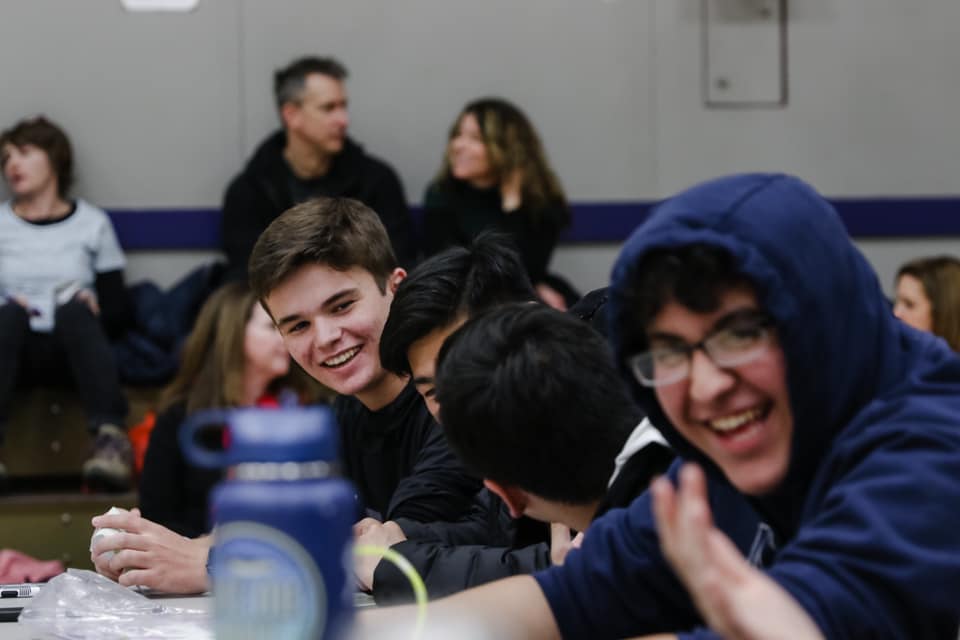
Melrose High School and Winchester High School Reach Leadership hosted a Trivia Night in 2019. This 2-hour event was free admission to watch and $5 per person to play. It was held at a local YMCA that donated the space.
Multiple raffle baskets and concessions, obtained through donation, were sold. Additionally, there was an info table with a donation box where club members answered questions about Family Reach. A local comedian and MHS student hosted and MC’d the event, asking the trivia questions. Board members and advisors worked to operate any technical difficulties and keep track of each team’s points. The winners received a basket of Family Reach merchandise and Red Sox tickets that were donated by a club member.
Club members brainstormed trivia questions, collected raffle and concession donations, created and distributed flyers, decorated the venue, and more. Board members worked through technical difficulties and oversaw all club members volunteering that night. An MHS photography student donated time to take pictures of the event.
Funds raised: $1000
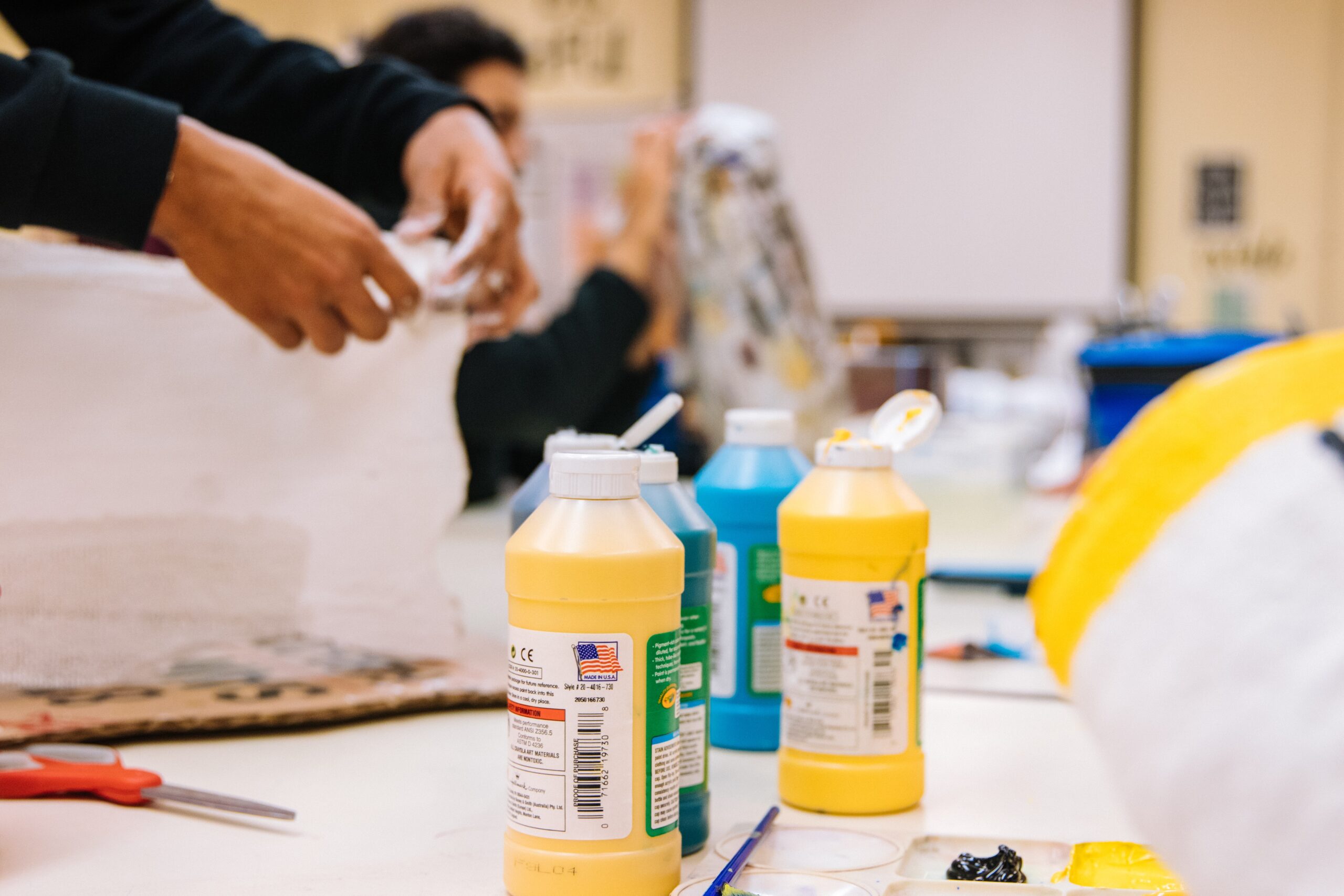
With help of an art teacher or local art studio, bulk paint could be donated or purchased for a painting class. This event could be held in person, or virtually through a platform such as Zoom. Depending on the cost of supplies, the entry fee could range from $30-40 to cover supplies and still make a profit.
Club members could collaborate with the art teacher/studio to determine what kind of painting will be demonstrated. Additionally, members can collect raffle and concession donations, create and distribute flyers, decorate the venue, and more. Board members can work through technical difficulties, oversee club member activities, and connect with Family Reach or other supportive organizations as needed.
Funds raised: If 40 people attended this event, and the price was $40 per person, assuming supplies were donated, this event could make approx $1600 on entry alone.

This is one of the most simple, low-effort ways to fundraise. Money made through such events could be used to support the club’s purchases for decorations, supplies, food, etc. Visit the determined restaurant’s website and follow the prompts to set up a fundraiser. Typically, a flyer is provided to you and can be used for promotion. Consider asking the restaurant if you can bring raffles, an information table, or a donation box to the night of the event.
Social Media
Suggested Platforms
Instagram Best Practices
Keep your usernames and platforms in a document accessible by board members, advisors, and chapter members as needed
Keep your username straightforward and consistent across all social platforms.
Add information to your bio that shares who you are. Tag @familyreach and include a clickable URL, preferably directing people to your LinkTree.
Keep captions professional, brief, and use appropriate grammar and spelling. Utilize hashtags and add locations to posts.
Suggested Hashtags
Keep a list of your hashtags saved in a notes application or document that is shared with the club and board members.
Facebook Best Practices
You will first need to set up a personal Facebook account if you do not have one already. It is recommended that members of your board do so as well, so they can be admins on your new Reach Leadership Facebook page.
We recommend choosing page topics such as Nonprofit Organization or Education. Add a profile picture and header to your page before posting. Include the link to your LinkTree in the website section of your bio
Use the same or a similar bio you used to make your Instagram page.
Keep captions professional, brief, and use appropriate grammar and spelling. Utilize hashtags and add locations to posts.
Invite your Facebook friends to like your page.
How to Create a LinkTree for your Social Media Accounts
Maintaining Your Social Media Pages
Post frequently and efficiently. Strive for 2-3 posts a week, and more is an event or campaign is coming up.
Consider posting live content from events on Instagram or Facebook stories.
Stick to Family Reach’s branding guidelines and themes, using signature purple and green colors where applicable.
Repost posts from Family Reach’s social media, either on stories or in a formal post.
Have 1-2 club or board members proofread and approve all posts. always use correct grammar, spelling, punctuation and Family Reach/cancer language.
Keep your LinkTree up to date!
Always request permission to post pictures of patients and families. Refer to the Connection with Families section on the Family Reach website and contact Nicole Ackerman with any questions regarding family relations.
Basic Graphic Design
Basic Graphic Design Philosophies
Voice
Clear, direct, friendly, and straightforward. We hit the hard stuff straight on, without over-dramatizing. Our priority is explaining the issue, and helping our community understand the tangible impact they can have by joining us. We want to educate and empower people to take action, without overly saddening or confusing them.
Communication Style
Always have a professional tone
Make sure you are capitalizing everything and using correct terminology/spelling
Always have someone proofread and approve your posts
Tone
Usually informal, but always sensitive and thoughtful. Within the oncology space, our tone tends to be a little more serious and fact-driven. In our writing, we try to consider the audience and adjust the tone accordingly. Are they looking for a cause to get involved with? Once we have an idea of their emotional state, needs, and baseline understanding of our mission, we adjust our tone accordingly.
Family Reach Brand
Strive to always stay on brand, but don’t feel limited if different colors would better suit specific events. For example, perhaps using a gold color for a childhood cancer awareness event, or blue for a winter themed event, would make the most sense. See the resources below for approved Family Reach branding.
Family Reach Colors
Green
Hex: #85c446
RGB: 133 196 70
Light Gray
Hex: #A8A8A8
RGB: 168 168 168
Purple
Hex: #824B87
RGB: 130 75 135
Accent Gray
Hex: #f9f9f9
RGB: 249 249 249
Gray
Hex: #64e7b
RGB: 100 110 123
Black
Hex: #232323
RGB: 35 35 35
Family Reach Typefaces
Montserrat
Primary Font. Use for headers, and to call attention to short sentences with larger text. Avoid using for extended passages.
Use for body copy and long paragraphs. Do not use for headers.
Arial
Used as a back up when other fonts are not avaliable.
Family Reach Approved Design Assets
Family Reach Logos
For Family Reach’s full brand and style guidelines, please refer to our Creative Expression
Graphic Design Resource: Canva
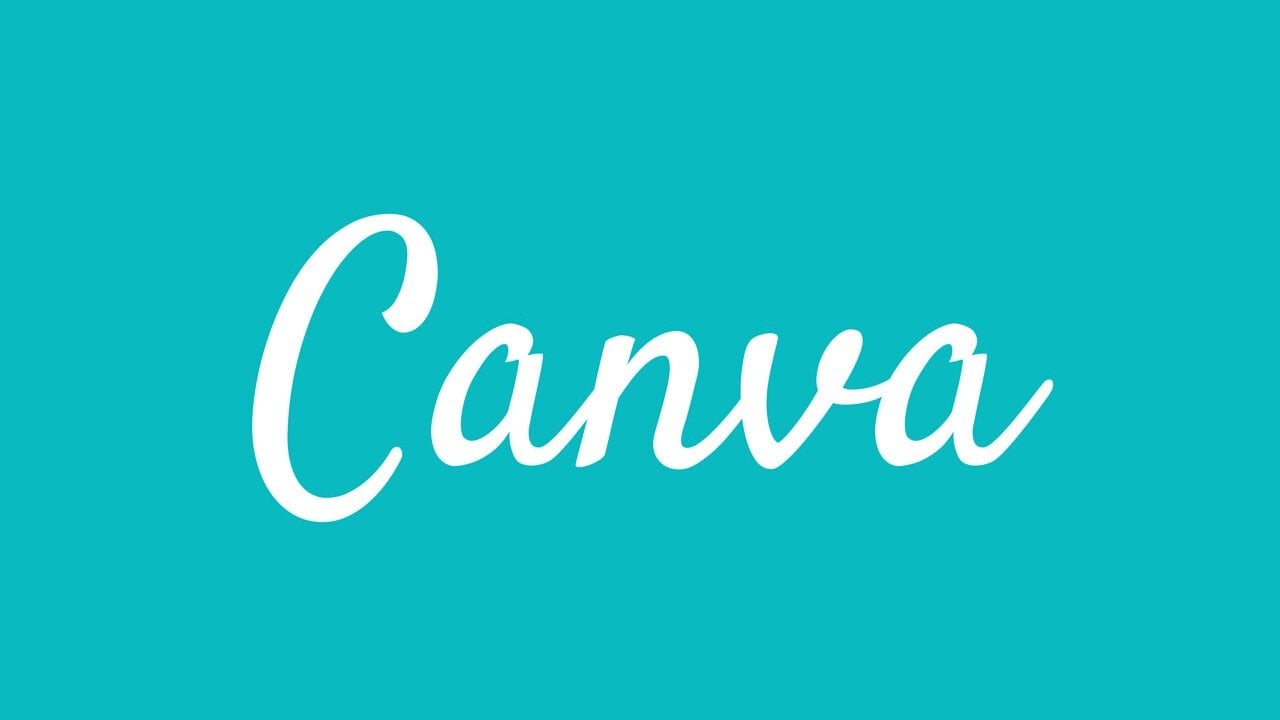
Canva is available as both a web browser and mobile app, which makes designing infographics and flyers easy even for non designers. It comes with pre-sized social media templates, pre-designed templates to get your graphics started, size and shape options, and stock images that are free to use. Through making an account, you can save your images to edit or download later, and it is easy to make multiple, similar graphics from one template!
Head over to Canva.com. If it’s your first time, you’ll have to set up an account. Click the ‘create a design’ button in the top right corner. You can pick from ‘custom dimensions’ or a range of pre-selected sizes. Canva makes it easy to start your design by including templates for the optimal sizes on many social media platforms.
Getting Started with Canva
To utilize the HEX or RGB color codes in Canva, click the rainbow color square in the left upper corner of your screen.
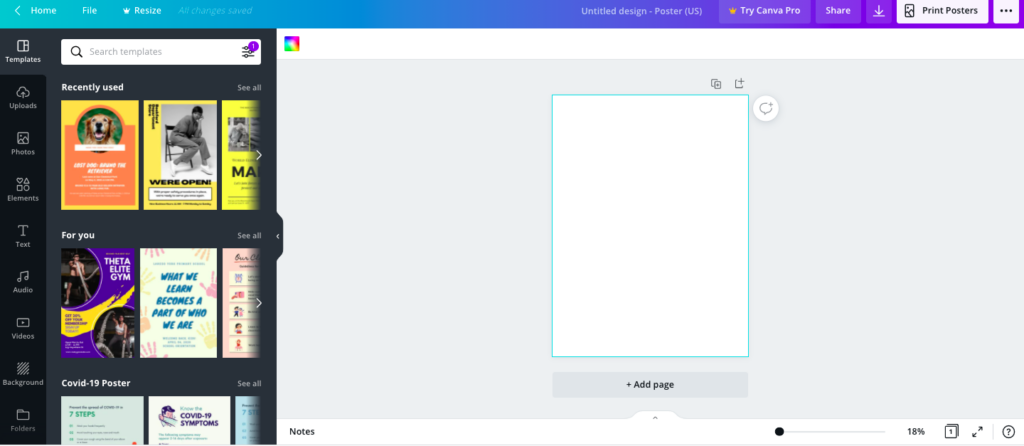
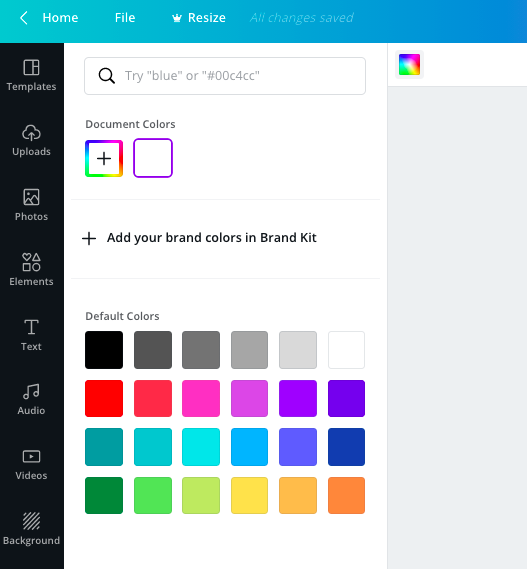
Clicking this will prompt this screen to pop up.
Click the square with the “+” and enter the HEX or RGB code you are looking for.
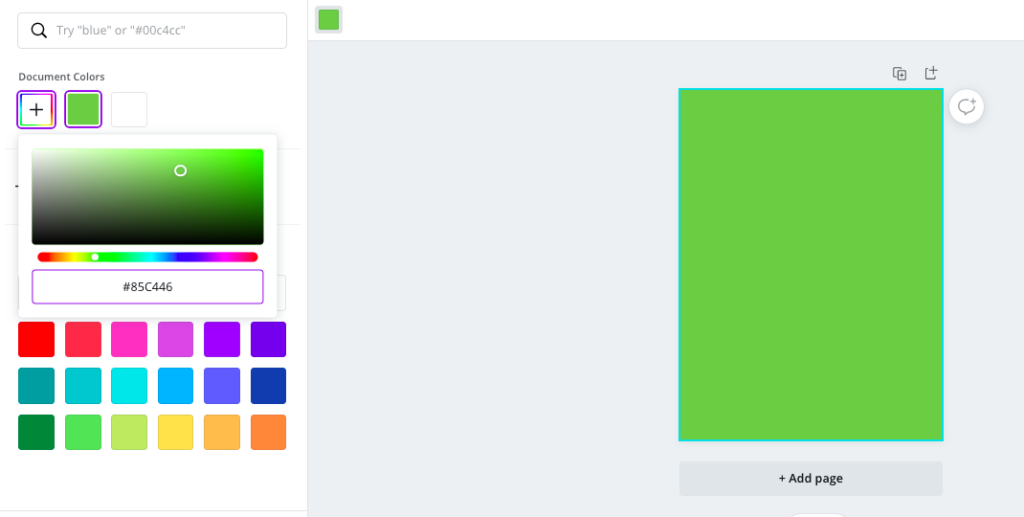




Clicking this will prompt this screen to pop up.
LIFEHACK! Upload the Reach Leadership logo into Canva and place the image in your document template. You easily have the Family Reach logo colors, as well as some similar accent colors, available listed as “Photo Colors”. While having the photo in your design, you can change the background and text to these suggested colors without having to search for them!
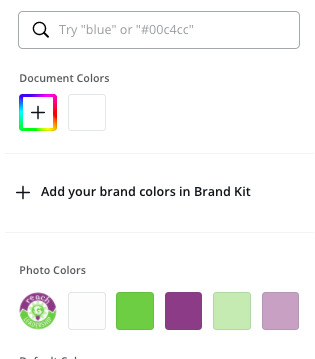

Making Event Flyers
Flyers can be used to spread the word around your community. The most common size is 8.5 x 11 in, which is the size of a standard piece of paper. Larger flyers can be 11 x 17 in and smaller flyers (or postcards) can be 5.5 x 4.25 in. How you plan to spread the word will determine the size.
Effective flyers have a few things:
A catchy, attention-grabbing headline
Appropriate visual hierarchy
For more information, Google search principles of design.
A clear message and call to action
High-quality images
No stealing! Look for “royalty-free” photos if you are in need of stock photos. Check out unsplash.com.
Legible and consistent font choices
Pick a font for headers, subheaders, and body copy. Then stick to them!
Be careful when using “display fonts”— they are notoriously hard to read, especially in long passages.
No low-res graphics
If it looks blurry on your computer, it will not print well.
Above all, design with your target group in mind. You want the right people to see your ad and spread the word, so create it for them. Make sure you include your brand colors and logo, eye-catching images and illustrations, an attention-grabbing title, and just enough text to get your point across. Add contact information like your website, email and phone number, and important details like the date and time of your event.
Additional Tips:
- Be generous with margins! Softwares such as Microsoft Word and Google Docs have pre-made margins. Allow ample margins when using software such as Canva.
- Use high contrast colors with text. (For Example: when using a purple background, use white text.)
- Test your design! Can a friend or co-worker look at it for only 5-10 seconds and understand the core message you are trying to get across?
- Use guides and the “Tidy Up” feature in Canva to make sure spacing is consistent between your elements
- For picking colors: RGB = Digital / CMYK = Print
- Proof your design before calling it final. Try printing it, asking a friend for feedback, or walking away from your computer for a bit so you can look at it with a fresh set of eyes.
Connecting With Families
Family Reach provides financial services through our Financial Treatment Program (FTP) to families across the country in all 50 states.
Sharing Family Stories
Given our extensive reach and national impact, we are able to share some stories from the families who have benefitted from Family Reach support. These stories will help you explain Family Reach’s mission to your audience, and motivate them to support families like the ones you share with them. As part of your social media and email outreach campaigns for your event, we can provide some consented family stories from your state and region (when possible) to highlight the impact you are having on a national cause, but also right in your own community.
Please read and understand the following guidelines when requesting a family story:
If deemed appropriate by Family Reach staff, a participating Reach Leadership chapter may be introduced to a family to serve as inspiration to their club members as a way to inspire their supporters & classmates by learning about a real family who has benefited from Family Reach support.
*At least one month notice must be provided for Family Reach to identify a consented family story to share.
If deemed appropriate by Family Reach staff, the Reach Hero/Inspiration Family may be invited to share their story and photo, for the Reach Leadership chapter to share in their fundraising & awareness efforts. Family Reach will have received a signed letter of consent from the Reach Hero/Inspiration Family before sharing any parts of their story or image with a Reach Leadership chapter.
If deemed appropriate by Family Reach staff, the Reach Hero/Inspiration Family may be introduced to the Reach Leadership chapter’s members via email to further inspire the group. All email communications with the family will be facilitated by Family Reach family relations staff.
If deemed appropriate by Family Reach staff, taking into consideration health, well-being, budget, and location, the Reach Hero/Inspiration family may be invited to attend a Reach Leadership chapter’s fundraising event to share their story and photo, telling their cancer experience and how Family Reach helped their family. A Family Reach family relations staff member must be present at the event to facilitate a Reach Hero/Inspiration Family attendance and cover expenses incurred by the family to attend.
If deemed appropriate by Family Reach staff, taking into consideration health, well-being, budget, and location, an in-person meeting may be arranged by the Family Reach family relations team for the Reach Leadership chapter to meet the family in person. A Family Reach family relations staff member must be present for this meeting. All communication between club members and Reach Hero must include Family Reach family relations staff. Family Reach will be released of all obligations and responsibilities of any relationships formed between club members and Reach Hero after any event.
Family Relations staff can be reached through Nicole Ackerman, [email protected]. Nicole’s typical office hours are 9am-5pm EST, but she can be available before or after hours if necessary to accommodate a family or a Reach Leader’s schedule. You may email Nicole at any time of day and will hear back from her within 24-48 hours, however, Nicole may need 3-5 days to hear back from a family.
Please note: stories from your region will not reflect patients whom your event is directly impacting, but rather are meant to serve as an example of the type of relief the money raised through your efforts will provide to similar patients and families across the country.
What/What Not To Say To Families
Don’t incorporate your personal religion or prayers in your messaging to families.
Be careful when saying “Get Well Soon”, as it may be a long and difficult recovery. It is better to say “Thinking of You”.
As Reach Leaders, never promise additional support from Family Reach.
Tips for In-Person Engagement With Families
- Keep it light and non-intrusive
- Don’t ask specifics of diagnosis, never give medical advice, don’t compare with other cancer cases
- Talk about hobbies, interests, etc.
- Be sincere, maintain eye contact, be natural, and listen
- Never promise additional Family Reach support, Refer to a Family Reach staff member to handle any service requests
- While we don’t encourage it, if you do connect with a family on social media, please follow the same protocol, maintain professional guidelines at all times, and refer them to a Family Reach staff or resource navigator if extra support is needed
Family-Centered Campaigns
For young leaders, it is beyond valuable to learn about family stories and see the impact of your hard work. MHS Reach Leadership launched the Patient Package Initiative to become involved in direct patient outreach. Family Reach staff members connected our chapter with 5 deserving families to receive a package tailored to their wants and needs.
We received a picture of the child, information about their battle, and how Family Reach stepped in to help when financial barriers occurred. Our members were able to learn about their stories, which inspired and motivated them to want to help. The chapter was separated into groups, each focusing on creating Amazon Gift Registries and cards for a child and their family. We considered the wants and needs of the child, as well as their parents/guardians, and siblings. Items such as toys, clothes, books, and items to help with well-being and cancer treatment were considered. With the permission of the Family Reach staff and each family, we shared the supplied stories, pictures, and gift registries to social media. We were blown away by how much our community stepped up to support, all items on the 5 registries were purchased within a week. We also received over $300 in donations through Venmo, which supported the purchasing of gift cards for families, and shipping costs as well. Members decorated each box to the child’s interests. The most rewarding part was receiving pictures and notes from families, and this project was the highlight of many member’s Reach Leadership experiences.
This type of campaign is encouraged for Reach Leaders to get connected with families and support them in different and creative ways. It is important to note that these campaigns require careful planning and a longer period of preparation, and are subject to family availability.
Useful Documents
Here are some additional resources to help get your Reach Leadership chapter started! Click on an icon below to download each document.
